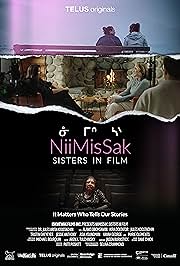Eye For Film >> Movies >> NiiMisSak: Sisters In Film (2024) Film Review
NiiMisSak: Sisters In Film
Reviewed by: Jennie Kermode

Indigenous film has changed a great deal over the span of just a few decades. “You could always hear a big British voice explaining,” recalls Alanis Obomsawin of the National Film Board of Canada, whose words bookend this documentary. When she suggested that the subjects of those films be allowed to speak for themselves, she was greeted with disbelief. Producers still saw them as childlike, ‘savage’, not capable of agency in a civilised context. Obomsawin’s narration in 1977’s Mother Of Many Children was not initially well received – but it was a start.
Jules Koostachin’s documentary brings together the voices of several different Native American women who write, direct and sometimes produce films. Although only 1% of female-identified directors in the land now known as Canada are female, there is plenty of variety among them. They are old and young, queer and straight, from different cultures scattered across a wide geographical area. There is a two-spirit contributor (with female and male aspects). There’s a woman from a filmmaking family, and there are others who never thought they could engage with this form of storytelling because they never saw themselves onscreen – even in adverts. What they have in common is a deep passion for the medium and a drive to succeed, recognising that much more than their individual dreams is at stake.

Simple in structure, with a series of interviews supported by clips of film, the documentary finds its power in the accumulation of ideas across its running time, and in the way that the women take inspiration from one another. The network they have formed is something that would be beneficial to almost any writer or director, short film maker Asia Youngman explains, because of the isolation and weight of responsibility that frequently accompany the work. In light of this, it makes still more sense that this story be told by someone who is herself an indigenous female filmmaker, and it opens with a lengthy section in which Koostachin discusses her own work. This helps to contextualise the rest, as she addresses the tension between addressing important but distressing subjects and demonstrating their ability to make other kinds of film, as well as finding room for indigenous joy. She talks about her own role in identifying gaps in what’s out there and endeavouring to fill them by, for instance, making films about menopause, about traditions around the placenta, and about missing and murdered indigenous women.
Pressure to make the ‘right sort’ of films sometimes comes from within indigenous communities, says Brother I Cry director Jessie Anthony, who was determined to tell her own brother’s story despite others’ concerns that drug abuse could make a bad impression. She’s cheered by the fact that efforts are now being made to create more opportunities for indigenous women in film, but notes that it’s a very slow process, and it would be much easier to achieve balance in the industry if a lot of cis white men would just get out of the way.
Tristin Greyeyes feels that the key to change lies in making conscious efforts to be more intersectional, on building each other up and in gifting space and time for learning. They also stress the importance of managing practical issues like childcare, and credit the babysitters who make their own work possible in each of their films. Marie Clements, who is happy simply to be present in changing times given the way things were before, is still frustrated by the presence of a glass ceiling affecting indigenous people in every aspect of the industry. Want to take meaningful action to give people opportunities? “Just hire them, for God’s sake!” she says.
Clements is also interested in the different types of storytelling that indigenous women can bring to cinema, expanding on Koostachin’s own ideas about the potential to create new structures and forms. Kayah George, the great granddaughter of Seventies star Chief Dan George (who made a difference in the industry himself when he refused to take on villain roles), is driven in part by the simple desire to tell stories in which women like her have personality and agency, rather than simply being the love interest for white guys. She also emphasises the need for cultural specificity and, accordingly, the representation of cultural teachings – noting that many of these were actually illegal until recently.
Obomsawin carved out a space for herself in the industry despite growing up without electricity or running water. Now 91, with 57 films under her belt, she continues to work. She’s sexy, stylish, and utterly unwilling to give way on the things that matter. Her reward lies in seeing how many talented women have followed her. “I lived long enough to see the difference,” she says with a smile.
Crammed full of important ideas, NiiMisSak: Sisters In Film is a great crash course on what’s happening in this area of cinema, an introduction to some significant talents, and an opportunity to get up to speed on key conversations around bringing the industry up to date. Perhaps most excitingly for casual viewers, it heralds a new wave of films which promise new experiences and new ways of seeing the world.
Reviewed on: 22 Jun 2025
















